Case Study: Holly lumbar strains from abdominal surgery scars
In my late teens I had surgery in my abdomen to remove my gallbladder laparoscopically. It left three scars, one a few inches inferior to my sternum and two more lateral and inferior on my right torso.
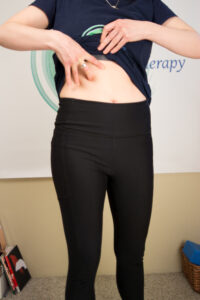
Three scars are under the tips of my fingers
Inside my torso there is certainly scar tissue surrounding the surgery site and a gap the size of a thumb where the organ used to lie. Scars and the memories associated with the healing process can disrupt movement patterns for years to come if they’re not investigated and retrained.
In my case I have a history of repeated psoas and quadratus lumborum strains on the left side and a left scapula that won’t fully retract. I have also discovered that I have trouble dropping my pelvis on the right side and lateral hip pain when I start running several days a week.
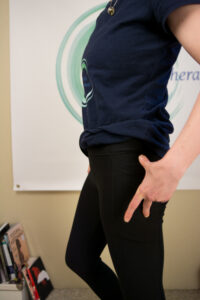
Pointing out the site of tension and pain on my lateral hip
Through a process of discovery and the use of the check in process of Anatomy in Motion, I have followed the clues in my body to discover the role of my surgery scars in my repeated injuries. Here is my process of unravelling these patterns.
If I have surgery scars in my right torso it would make sense that both the scar adhesions and the protective memory of the surgery healing process would mean I don’t want to open that area of my body. And this would be true in all three planes of movement; sagittal, frontal and transverse.
First off I had a session with Monika Volkmar in Toronto using the AiM process, and she discovered that my ability to drop my pelvis on the right while laterally flexing my ribcage to the left was missing. So she gave me an exercise to start getting opposition between my pelvis and ribcage in the frontal plane
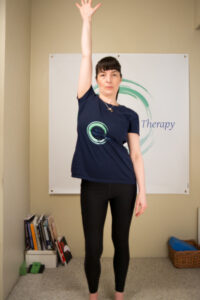
Learning to drop my pelvis on the right while laterally flexing my ribcage to the left
This lost movement makes sense because my nervous system and scar tissue would be reluctant to take the ribcage and pelvis in opposition. It’s likely that my body chose a work-around to create the necessary movement in my body but in a different plane.
The second pattern I noticed was I had trouble rotating my ribcage to the left as I rotated my pelvis to the right. Again, not wanting to move my ribcage and pelvis in opposition meant I was missing my range of motion in this plane, too. To restore this movement I placed my legs one in front of the other about natural stride length and pelvis width apart. Then I rotated my pelvis to the right and I rotated my ribcage to the left. I used my right arm to accentuate the opposition.
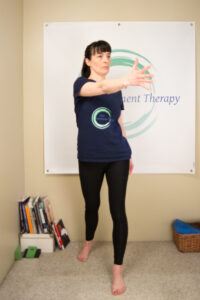
learning to rotate my ribcage in one direction and my pelvis in the opposite direction
The third movement I worked on was putting these two movements together in the gait cycle. When we load bear on one leg, we have out pelvis, ribcage and head stacked on top of each other. The pelvis and ribcage oppose each other in all three planes. What I discovered was that although I was getting anterior tilt in my pelvis, I was missing a clean hike and drop of my pelvis. Instead of hiking and dropping with my pelvis and ribcage stacked, I was creating more of a lateral shift in my pelvis.
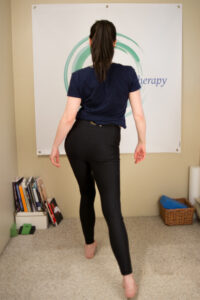
BEFORE: shifted pelvis off axis to the left
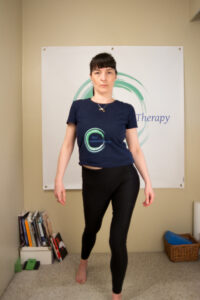
AFTER: Putting myself back on axis
I worked to ensure that when I was load bearing on my leg that my pelvis tilted stacked under my ribcage rather than shifting away from the stacked position. Hello QL!
What did this pattern have to do with my injury history? First, the QL. One of the QL’s jobs is to bring the pelvis back to centre. When you take the pelvis away from the spine, the QL lengths and brings the pelvis back to a level position. If I’m in the habit of creating a hike-drop through shifting my pelvis away from my spine, then it puts my QL in a vulnerable position to have to bring my pelvis back from a greater distance than it should have to. Whenever I moved my pelvis out of alignment, it was vulnerable to a strain. Secondly, the lateral hip pain. If I’m creating a hike-drop by shifting my pelvis away from my spine, it puts undue length into everything attaching to my greater trochanter. My IT band, TFL, Rec Fem, glutes, on and on. If every time I ran on that side or took a step on that side the pelvis was shifting over and putting pressure on those tissues, after awhile they will start to complain. Thirdly, the lack of retraction in my left scapula. If I’m reluctant to rotate my ribcage to the left, then I never get an opportunity to let my scapula retract fully towards my spine. Put all of these together and we discover that scars and memories from a surgery 25 years ago can still be impacting movement patterns.
I will also add that part of my discovery around my surgery scars included scar work using P-DTR with physiotherapist Julie Paul and chiropractor Jay Gaurino both of Tonume Integrated Health in Vancouver. Additional benefits of the P-DTR work on my scars included being able to access the right lateral diaphragm movement and improved lung capacity while running.
If you want to learn more about my work visit my website www.flowmovement.ca and be sure to check out my video content of Anatomy in Motion-based exercises on the Flow Movement Therapy YouTube channel.
